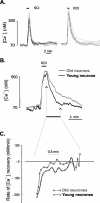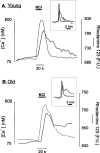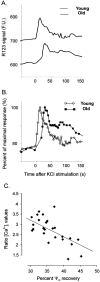Changes in mitochondrial status associated with altered Ca2+ homeostasis in aged cerebellar granule neurons in brain slices
- PMID: 12486169
- PMCID: PMC6758428
- DOI: 10.1523/JNEUROSCI.22-24-10761.2002
Changes in mitochondrial status associated with altered Ca2+ homeostasis in aged cerebellar granule neurons in brain slices
Abstract
In the present work, we investigated the relationship between mitochondrial function and Ca2+ homeostasis in brain slices obtained from mice that aged normally. In acute preparations, the cerebellar neurons had similar values for intracellular free Ca2+ ([Ca2+]i) regardless of their age (range, 6 weeks to 24 months). However, compared with the young slices, the aged neurons (20-24 months) showed an enhanced rate of [Ca2+]i increases as a function of the time the slices were maintained in vitro. When slices were stimulated (KCl depolarization), there were significant differences in the patterns of [Ca2+]i signal displayed by the young and old cerebellar granule neurons. More importantly, the aged neurons showed a significant delay in their capacity to recover the resting [Ca2+]i. The relationship between [Ca2+]i and mitochondrial membrane potential was assessed by recording both parameters simultaneously, using fura-2 and rhodamine-123. In both young and aged neurons, the cytosolic [Ca2+]i signal was associated with a mitochondrial depolarization response. In the aged neurons, the mitochondria had a significantly longer repolarization response, and quantitative analysis showed a direct correlation between the delays in mitochondrial repolarization and [Ca2+]i recovery, indicating the causal relationship between the two parameters. Thus, the present results show that the reported changes in Ca2+ homeostasis associated with aging, which manifest principally in a decreased capacity of maintaining a stable resting [Ca2+]i or recovering the resting [Ca2+]i values after stimulation, are primarily attributable to a metabolic dysfunction in which the mitochondrial impairment plays an important role.
Figures









Similar articles
-
Mitochondrial polarisation status and [Ca2+]i signalling in rat cerebellar granule neurones aged in vitro.Neurobiol Aging. 2004 Mar;25(3):349-59. doi: 10.1016/S0197-4580(03)00123-4. Neurobiol Aging. 2004. PMID: 15123341
-
Neuronal ageing in long-term cultures: alterations of Ca2+ homeostasis.Neuroreport. 2000 Nov 27;11(17):3725-9. doi: 10.1097/00001756-200011270-00027. Neuroreport. 2000. PMID: 11117480
-
Age-associated changes of cytoplasmic calcium homeostasis in cerebellar granule neurons in situ: investigation on thin cerebellar slices.Exp Gerontol. 1996 Jul-Aug;31(4):475-87. doi: 10.1016/0531-5565(95)02070-5. Exp Gerontol. 1996. PMID: 9415105
-
The leading role of mitochondrial depolarization in the mechanism of glutamate-induced disruptions in Ca2+ homeostasis.Neurosci Behav Physiol. 2002 Sep-Oct;32(5):541-7. doi: 10.1023/a:1019819925257. Neurosci Behav Physiol. 2002. PMID: 12403008
-
Ca2+ and mitochondria as substrates for deficits in synaptic plasticity in normal brain ageing.J Cell Mol Med. 2004 Apr-Jun;8(2):181-90. doi: 10.1111/j.1582-4934.2004.tb00273.x. J Cell Mol Med. 2004. PMID: 15256066 Free PMC article. Review.
Cited by
-
H2O2 Signalling Pathway: A Possible Bridge between Insulin Receptor and Mitochondria.Curr Neuropharmacol. 2012 Dec;10(4):311-20. doi: 10.2174/157015912804143559. Curr Neuropharmacol. 2012. PMID: 23730255 Free PMC article.
-
Age-dependent changes in Ca2+ homeostasis in peripheral neurones: implications for changes in function.Aging Cell. 2007 Jun;6(3):285-96. doi: 10.1111/j.1474-9726.2007.00298.x. Aging Cell. 2007. PMID: 17517039 Free PMC article. Review.
-
Aging is associated with elevated intracellular calcium levels and altered calcium homeostatic mechanisms in hippocampal neurons.Neurosci Lett. 2007 May 11;418(1):77-81. doi: 10.1016/j.neulet.2007.03.005. Epub 2007 Mar 12. Neurosci Lett. 2007. PMID: 17374449 Free PMC article.
-
Genome-wide transcriptomics of aging in the rotifer Brachionus manjavacas, an emerging model system.BMC Genomics. 2017 Mar 1;18(1):217. doi: 10.1186/s12864-017-3540-x. BMC Genomics. 2017. PMID: 28249563 Free PMC article.
-
The effect of aging-associated impaired mitochondrial status on kainate-evoked hippocampal gamma oscillations.Neurobiol Aging. 2012 Nov;33(11):2692-703. doi: 10.1016/j.neurobiolaging.2012.01.001. Epub 2012 Mar 8. Neurobiol Aging. 2012. PMID: 22405041 Free PMC article.
References
-
- Ames BN, Shigenaga MK, Hagen TM. Mitochondrial decay in aging. Biochim Biophys Acta. 1995;1271:165–170. - PubMed
-
- Barnes CA. Normal aging: regionally specific changes in hippocampal synaptic transmission. Trends Neurosci. 1994;17:13–18. - PubMed
-
- Campbell VA, Segurado R, Lynch MA. Regulation of intracellular Ca2+ concentration by interleukin-1β in rat cortical synaptosomes: an age-related study. Neurobiol Aging. 1998;19:575–579. - PubMed
-
- Cortopasi G, Wong A. Mitochondria in organismal aging and degeneration. Biochim Biophys Acta. 1999;1410:183–193. - PubMed
Publication types
MeSH terms
Substances
LinkOut - more resources
Full Text Sources
Medical
Miscellaneous
